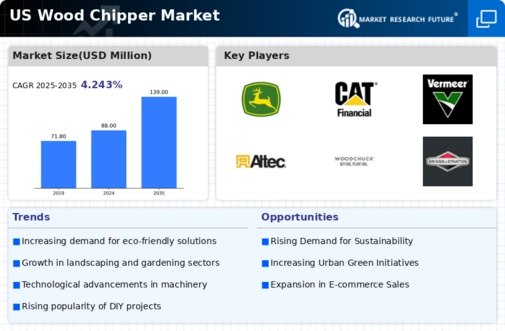The US Wood Chipper Market is characterized by robust competition among various players seeking to capitalize on the growing demand for land clearing, waste management, and landscaping applications. Factors such as increasing focus on environmental sustainability and forest management practices have significantly boosted the market, leading to an influx of innovative wood chipper designs and technology.
Competitive insights reveal that leading manufacturers are diversifying their product offerings and enhancing distribution channels to gain a competitive edge. Moreover, the emphasis on quality, efficiency, and serviceability continues to play a crucial role in shaping market dynamics, as players are continually striving to meet the specific needs of end users across different sectors, including construction, forestry, and agriculture.
John Deere has a notable presence in the US Wood Chipper Market, where its brand is synonymous with reliability and innovation. Strengths of John Deere include its well-established distribution network and strong brand reputation, which have solidified its position among both commercial and residential customers. The company is recognized for its advanced engineering capabilities that lead to the development of high-performance wood chippers tailored for various applications.
Furthermore, John Deere's commitment to sustainability is reflected in its product offerings, which emphasize efficient fuel consumption and reduced emissions, thereby appealing to environmentally conscious consumers. As a result, the company's product line in the wood chipper segment continues to gain traction amid an increasingly competitive landscape.
Caterpillar's involvement in the US Wood Chipper Market is marked by its well-recognized brand and extensive experience in heavy machinery and equipment. Caterpillar specializes in manufacturing equipment that supports land clearing and waste processing, with an emphasis on durability and efficiency. Key products include heavy-duty wood chippers designed to handle large volumes of waste materials, which cater predominantly to commercial applications in construction and forestry industries.
The company's strengths lie in its technological advancements, focusing on enhancing the operational efficiency of its equipment through automation and precision engineering. Caterpillar's market presence is augmented by strategic mergers and acquisitions that expand its capabilities and product portfolio, ensuring that it remains competitive in the evolving landscape of the wood chipper market in the United States.























